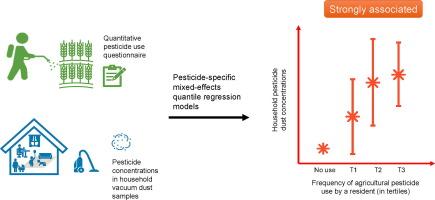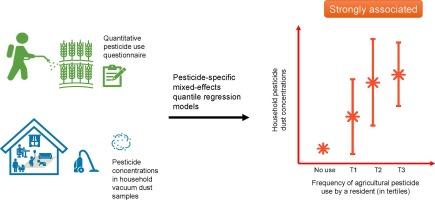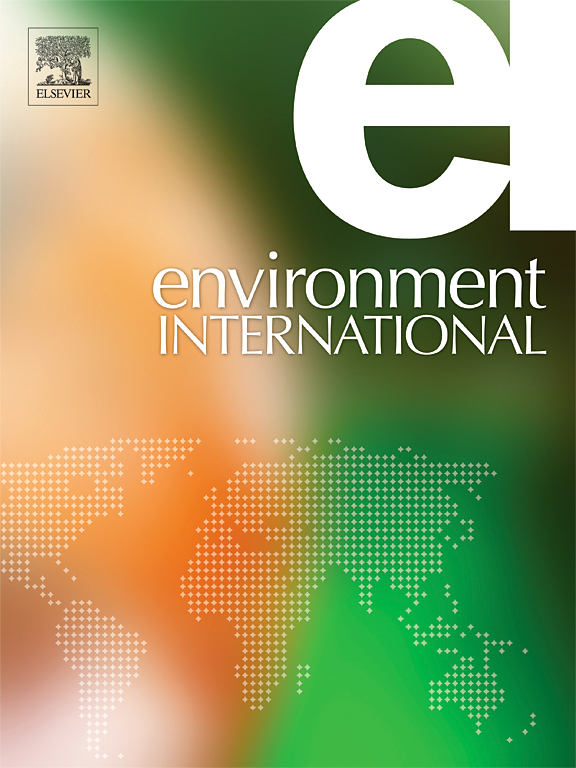近期和终生农业杀虫剂使用量的定量测量与室内灰尘中杀虫剂浓度的增加有关
IF 10.3
1区 环境科学与生态学
Q1 ENVIRONMENTAL SCIENCES
引用次数: 0
摘要
目的在使用农用杀虫剂的居民家中的灰尘中发现了较高的杀虫剂浓度,但很少有研究将这些浓度与杀虫剂使用的定量指标进行比较。我们在农业暴露和影响生物标志物研究中评估了家庭农药灰尘浓度与农业农药使用的活性成分定量指标之间的关系。方法参与者提供了真空灰尘样本(2013-2018 年)以及最近(过去 12 个月)和终生使用农药的相关信息。在来自 213 名参与者的 295 份粉尘样本中测量了 32 种农药分析物;其中 54 人进行了重复测量(两次测量之间的中位数 = 96 天)。我们使用混合效应量子回归模型来估算近期和终生农业使用(天数、强度加权天数)、近期家庭/花园使用(是/否)和家庭特征在农药浓度方面的相对差异。由于没有使用信息,因此只对达克沙尔的家庭特征进行了研究。我们计算了类内相关系数 (ICC),以评估时间变异性。我们仅报告了检出率为 25% 的农药的描述性统计数据。结果对于目前使用的农药,近期农业使用的定量指标与马拉硫磷、甲草胺、乙酰甲胺磷、氟氯氰菊酯和阿特拉津的家庭农药粉尘浓度显著增加有关(p 趋势为 0.001),但与氯菊酯无关。同样,终生使用的定量指标与马拉硫磷、甲草胺、西维因、二嗪农和莠去津浓度的增加有关(p 趋势为 0.001),但与氯菊酯、毒死蜱或百菌清无关。就禁用农药而言,农业用途与氯丹和七氯浓度升高有关,与狄氏剂浓度升高无显著关系,但与林丹、p,p-DDD、p,p-DDE 或 p,p-DDT 无关。最近在家庭/花园中使用马拉硫磷、甲萘威和氟氯氰菊酯会导致浓度升高。ICC(范围 = 0.57-0.90)表明 3-6 个月内存在中度到高度相关性。甲草胺、丁酯、EPTC、甲拌磷、西玛津、呋喃丹、杀扑磷以及三种禁用农药(氰氨嗪、艾氏剂、硫丹)的检出率为 25%。本文章由计算机程序翻译,如有差异,请以英文原文为准。


Quantitative measures of recent and lifetime agricultural pesticide use are associated with increased pesticide concentrations in house dust
Objective
Elevated pesticide concentrations have been found in dust from homes with residents who use agricultural pesticides, but few studies have compared these concentrations to quantitative measures of their use. We evaluated household pesticide dust concentrations in relation to quantitative, active ingredient-specific metrics of agricultural pesticide use in the Biomarkers of Exposure and Effect in Agriculture Study.
Methods
Participants provided vacuum dust samples (2013–2018) and information regarding recent (last 12 months) and lifetime pesticide use. Thirty-two pesticide analytes were measured in 295 dust samples from 213 participants; 54 had repeated measurements (median = 96 days between visits). We used mixed-effects quantile regression models to estimate relative differences in pesticide concentrations for recent and lifetime agricultural use (number of days, intensity-weighted days), recent home/garden use (yes/no), and household characteristics. Only household characteristics were examined for dacthal because of no use information. We calculated intraclass correlation coefficients (ICCs) to evaluate temporal variability. We report only descriptive statistics for pesticides with detection rates <25 %.
Results
For currently used pesticides, quantitative measures of recent agricultural use were associated with significantly increased household pesticide dust concentrations for malathion, metolachlor, acetochlor, cyfluthrin, and atrazine (p-trends < 0.001), but not permethrin. Similarly, quantitative measures of lifetime use were associated with increased concentrations of malathion, metolachlor, carbaryl, diazinon, and atrazine (p-trends < 0.001), but not permethrin, chlorpyrifos, or chlorothalonil. For banned pesticides, ever agricultural use was associated with elevated chlordane and heptachlor concentrations and non-significantly elevated dieldrin concentrations, but not lindane, p,p-DDD, p,p-DDE, or p,p-DDT. Recent home/garden use predicted increased malathion, carbaryl, and cyfluthrin concentrations. ICCs (range = 0.57–0.90) suggested moderate to high correlation over 3–6 months. Detection rates were <25 % for alachlor, butylate, EPTC, metribuzin, simazine, carbofuran, coumaphos, as well as for three banned pesticides (cyanazine, aldrin, endosulfan).
Conclusions
Household pesticide dust concentrations were strongly associated with the frequency of agricultural pesticide use.
求助全文
通过发布文献求助,成功后即可免费获取论文全文。
去求助
来源期刊

Environment International
环境科学-环境科学
CiteScore
21.90
自引率
3.40%
发文量
734
审稿时长
2.8 months
期刊介绍:
Environmental Health publishes manuscripts focusing on critical aspects of environmental and occupational medicine, including studies in toxicology and epidemiology, to illuminate the human health implications of exposure to environmental hazards. The journal adopts an open-access model and practices open peer review.
It caters to scientists and practitioners across all environmental science domains, directly or indirectly impacting human health and well-being. With a commitment to enhancing the prevention of environmentally-related health risks, Environmental Health serves as a public health journal for the community and scientists engaged in matters of public health significance concerning the environment.
 求助内容:
求助内容: 应助结果提醒方式:
应助结果提醒方式:


